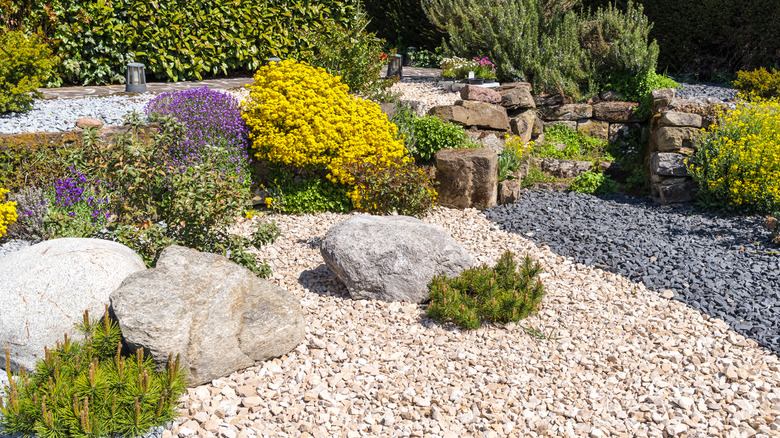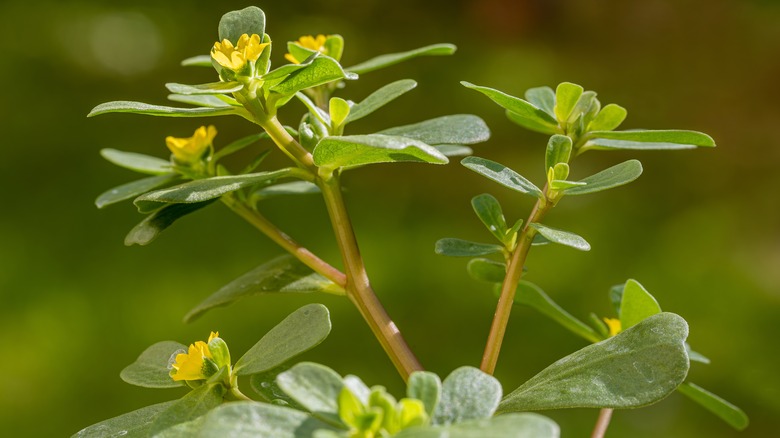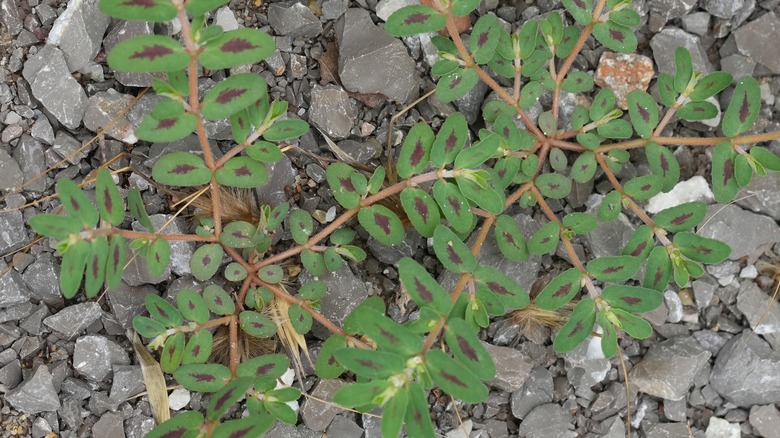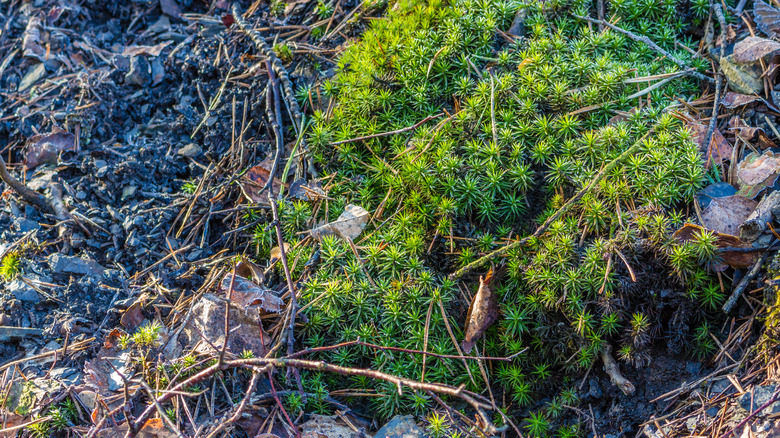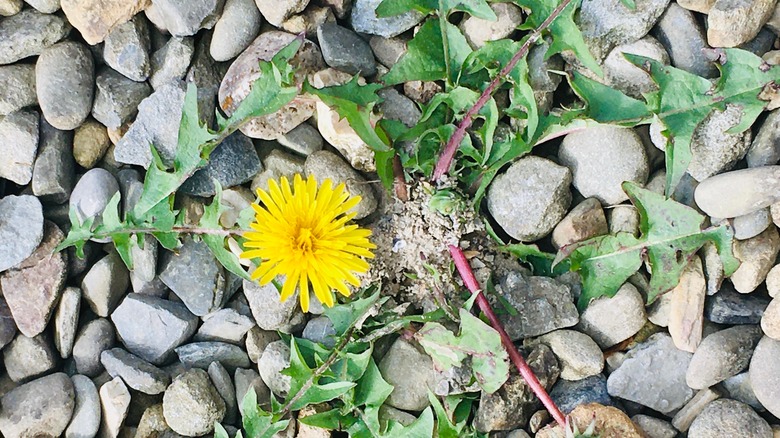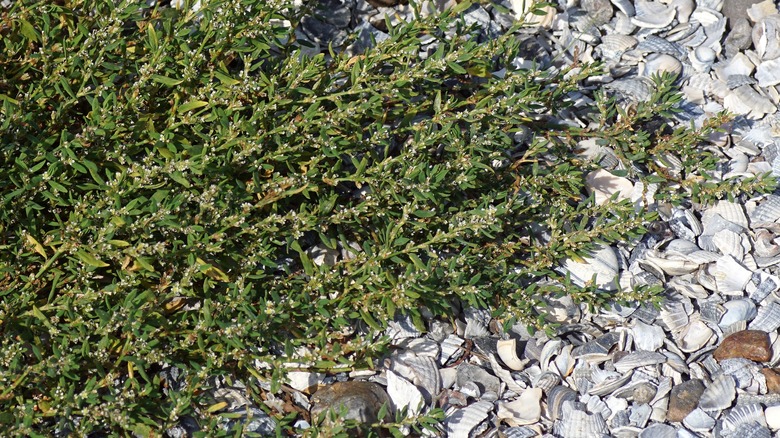Common Types Of Weeds Growing In Your Gravel (& How To Remove Them)
Nothing ruins the look of pristine gravel quite like a wilful weed forcing its way through the stony setting. Gravel, whether used as a flowerbed mulch, a topping for container plants, a driveway covering, or a pathway surface, unfortunately presents an ideal opportunity for weeds to thrive. Many of the most common weeds like to grow in disturbed conditions that see regular foot traffic or vehicular disruption, such as gravel paths and driveways. They also take hold best when there is no competition from native plants or turfs, which of course, rarely are in gravel. However, just because weeds will happily grow amongst gravel surfaces doesn't mean we have to let them.
The best means of removing a weed will depend on exactly which type of weed it is. This means that, before figuring out how to tackle the plant, you first have to identify it. Common weeds you can expect to see growing in your gravel include common purslane, dandelions, pearlwort, prostrate knotweed, and spotted spurge. These can usually be identified by their growing habit, and the look of their leaves, stems, and flowers. Once identified, you can determine your removal process, such as hand-pulling the weed or using a herbicide. One of the best ways to stop weeds from growing is to ensure your lawn is dense and healthy. This prevents weeds from competing and will help to choke them out. Unfortunately, in gravel, this is not an option for weed control, so you'll need to find other methods. Generally speaking, weeds should be removed before they flower. This prevents them from forming seeds, which will land in nearby soil and germinate to create more weeds. You can also consider preventative measures like using a weed barrier beneath your gravel.
Common purslane is a super spreader, so remove it before seedheads form
Common purslane (Portulaca oleracea) is a prevalent annual weed that appears each summer. The plant cannot survive frost and will be killed at the first sign of cold temperatures each fall. However, it can cause plenty of problems during the months it is alive. Purslane spreads aggressively and is known as one of the most noxious weeds in the world. You are especially likely to find common purslane emerging in gravel driveways or walkways because the shallow soil disturbed by foot traffic or vehicles makes for ideal growing conditions. Identify common purslane by its fleshy, succulent leaves with rounded ends that prefer moist conditions but can also thrive in drought. These leaves can be reddish purple in color, and you may see tiny yellow flowers in sunny conditions.
Time is of the essence when treating aggressive purslane because if it can produce seed heads, the spread will rapidly get out of control. A single common purslane weed will make around 240,000 seeds, and rather impressively, these will still be viable as many as 40 years later. It's essential to remove the plant by hand before the flowers have formed and seed pods follow, as this will interrupt the reproduction process of the weed and prevent it from spreading. To remove, pull the weed up by hand, making sure to get all of the thick taproot. Properly dispose of the weed, because even unrooted purslane can continue to develop seeds. If this proves ineffective, you can also spray the weeds before they emerge with the herbicide metribuzin.
Stop spotted spurge by taking out the taproot
Spotted spurge (Euphorbia maculata) is a major weed that thrives in gravel, cracks in sidewalks, and gardens. It is a warm-season annual weed that will appear in spring or summer and die back at the first sign of frost. It forms a dense mat on the ground, making it resistant to mowing. The weed spreads aggressively via seed, with each plant capable of producing thousands of seeds. As a result, spotted spurge must be removed early in the season before the plant has a chance to flower and set seeds. To identify it, look for a low-spreading ground cover with round, hairy leaves, where each leaf has a reddish spot in the center. If you break the stems, you'll notice a milky sap — but be careful, as it's toxic.
Spotted spurge weeds root deep into the soil, with chunky taproots extending as long as 2 feet. The best way to remove the weed is to dig it out manually, but the long taproot can make this tricky. You'll need to use a trowel or spade to work deep into the soil around the weed, taking care to remove all of the roots to prevent regrowth. Tiny pink flowers will bloom in summer, so it's ideal to remove the spotted spurge as soon as it's identified in spring or early summer. Remember that weeds should not be composted because they can still grow. As a last resort, try controlling the spread of this weed with pre-emergent herbicides or use a nonselective herbicide directly on the weeds, being careful not to spray any other plants.
Prevent prolific pearlwort weeds with pre-emergent herbicides
Pearlwort (Sagina procumbens) is a perennial plant that is especially problematic in gravel and containers, where it grows aggressively. The common weed was introduced from Europe and thrives in moist or wet conditions, forming dense mats of moss-like growth. Pearlwort produces tiny white flowers that are held on short stalks above the leaves of the weed. Each flower results in the production of numerous seeds, which are spread from splashes when nearby plants are watered or when there is rainfall. The seeds can sprout up over a foot away from the original weed.
You can manage the growth of pearlwort by improving drainage, since this weed thrives in areas where there is plenty of water. Hand-removing the weeds can also help to minimize the spread, but even the tiniest plants have extensive root systems which can be difficult to remove in their entirety. If you are going to attempt to pull out the weeds, ensure you do so before they flower. Chemical control is usually advisable for treating an aggressive match of pearlwort, but unfortunately, the sizeable root systems mean that herbicides often won't be able to treat the whole plant. Due to this, pre-emergent herbicides are your best chance of fully controlling the weed. Apply a herbicide that is indicated to work against pearlwort before the weeds emerge.
Destroy deep-rooted dandelions with a salt application
Stubborn dandelions (Taraxacum officinale) are a common sight in gravel, whether you have a gravel driveway, or garden footpath, or have used gravel as a mulch around your shrubs and flowerbeds. These strong-willed weeds will force their way through the toughest settings and thrive in almost any conditions. They can tolerate high levels of heat just as well as they can withstand freezing temperatures, making them a nightmare to get rid of. As prolific seeders, a single plant can produce as many as 20,000 viable seeds. To identify them, look for their yellow flowers that turn into fluffy white seed heads, jagged flat leaves, and reddish stems.
The best way to prevent dandelions from sprouting in your garden or amongst your gravel is to use a pre-emergent herbicide. This is because fluffy dandelion seeds can be carried far and wide in the wind from nearby yards or fields, so a pre-emergent herbicide is the only way to stop them from germinating. If you already have dandelions growing, you may be able to kill them with salt. This common kitchen ingredient will get rid of the weeds without any chemicals. Apply a few spoonfuls of salt into the middle of the dandelion in moist but not wet conditions, and the weed should be completely destroyed within a few days. This method is best used on gravel driveways and footpaths where desirable plants are not growing. Avoid using salt in gravel containers or flowerbeds because it makes the soil uninhabitable. You can also remove a few dandelions by hand-pulling, but ensure you get rid of the full taproot.
Pull up prostrate knotweed and relieve compaction to stop it coming back
Prostrate knotweed (Polygonum aviculare) is among the first broadleaf annual weeds to arrive in the spring or early summer, spreading vigorously along the ground at a surprising speed. This weed prefers to grow in compacted soil, so areas that experience lots of foot traffic, such as driveways and gravel paths, make an ideal home for prostrate knotweed. The super fine roots of the plant can bury themselves deep into even the most dense soils, and unfortunately, they are resistant to many chemical herbicides. You can identify prostrate weeds by their low-growing habit, with stringy stems and small leaves that form a dense mat on the surface of the ground.
Pull up prostrate knotweeds before they flower, preventing them from producing seeds and continuing to germinate year after year. In dense and compacted soil this can be tricky, so moisten the soil first with plenty of water to help the roots be tugged out more easily. After you've manually removed the weeds, you should make efforts to reduce the chances of them setting up camp in your gravel in the future. Since prostrate knotweeds love compacted soil, relieving compaction can help to create an environment they won't thrive in. Till the soil beneath your gravel to encourage aeration, and where possible, avoid too much foot traffic in that area. Mulching the soil is an alternative trick to prevent weeds from growing in your gravel that can stop prostrate knotweeds from germinating. When creating gravel pathways, lay several inches of sand on top of the soil to stop weed seeds from getting the light they need to sprout.
